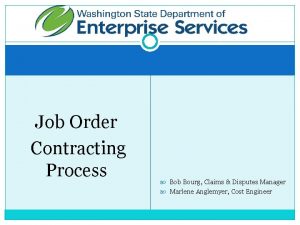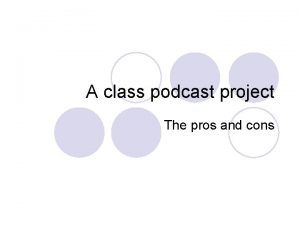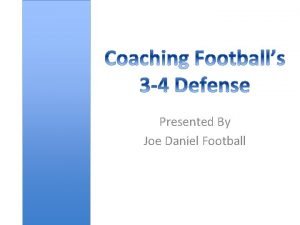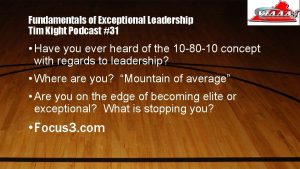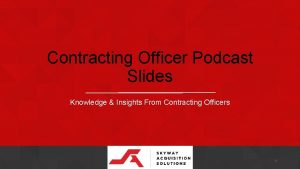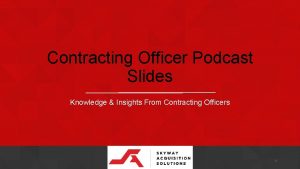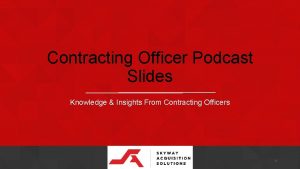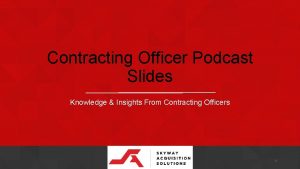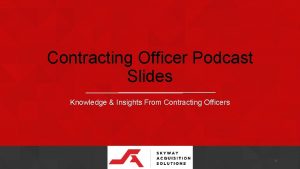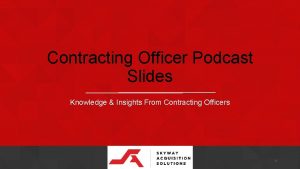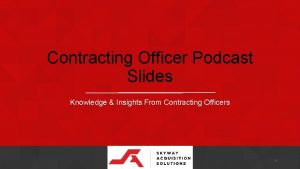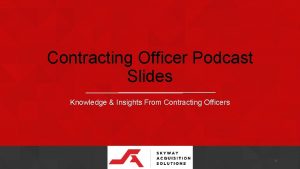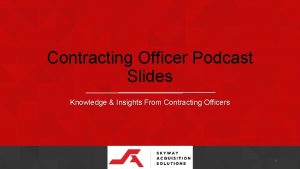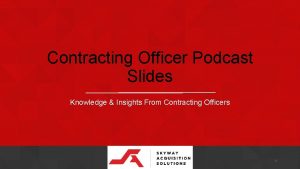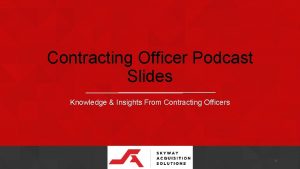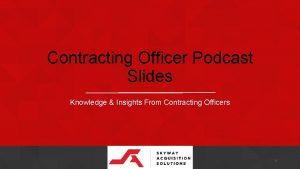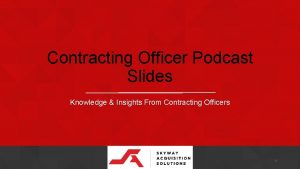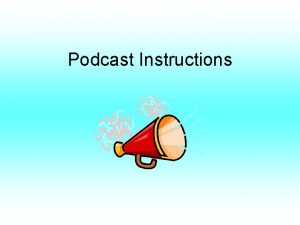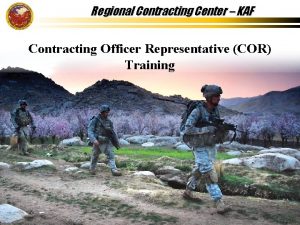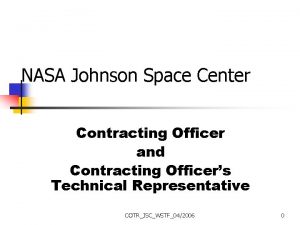Contracting Officer Podcast Slides Knowledge Insights From Contracting


















- Slides: 18

Contracting Officer Podcast Slides Knowledge & Insights From Contracting Officers 1

Episode 030 What is a Competitive Range Determination? Original Air Date: June 8, 2015 Hosts: Kevin Jans & Paul Schauer 2

Formatting notes • Hyperlinks: Blue font indicates hyperlinks – presentation must be in ‘Slide Show’ mode to activate the link • Red bold font indicates a point of emphasis • Green bold font indicates CO’s personal comment or perspective 3

Introduction • What is a Competitive Range Determination? • Book answer: FAR 15. 306 – Exchanges with Offerors After Receipt of Proposals (a) Clarifications and Award without Discussions (b) Communications with Offerors before Establishment of the Competitive Range 4

Introduction (c) Competitive Range – ‘establish a competitive range comprised of all of the most highly rated proposals’ • Unless reduced for efficiency (if you have too many qualified proposals) • Provide written notice to those who are eliminated, who can then request a debriefing (d) Exchanges with offerors after establishment of Comp Range (negotiations = discussions) 5

Introduction • What is a Competitive Range Determination? • Our answer: It is the start of negotiations • What does it do? • Saves the time of those who cannot win • Focuses the effort on the ones who CAN win • Gives Government a chance to negotiate for better proposals 6

FAR 15. 306(c) – Competitive Range (1) Agencies shall evaluate all proposals in accordance with 15. 305(a), and, if discussions are to be conducted, establish the competitive range. Based on the ratings of each proposal against all evaluation criteria, the CO shall establish a CR comprised of all of the most highly rated proposals, unless the range is further reduced for purposes of efficiency pursuant to paragraph (c)(2) of this section. 7

FAR 15. 306(c) – Competitive Range (2) After evaluating all proposals …, the CO may determine that the number of most highly rated proposals that might otherwise be included in the competitive range exceeds the number at which an efficient competition can be conducted. Provided the solicitation notifies offerors that the competitive range can be limited for purposes of efficiency (see FAR 52. 215 -1(f)(4)), the contracting officer may limit the number of proposals in the competitive range to the greatest number that will permit an efficient competition among the most highly rated proposals (10 U. S. C. 2305(b)(4) and 41 U. S. C. 3703). 8

FAR 15. 306(c) – Competitive Range (3) If the CO, after complying with paragraph (d)(3) of this section, decides that an offeror’s proposal should no longer be included in the competitive range, the proposal shall be eliminated from consideration for award. Written notice of this decision shall be provided to unsuccessful offerors in accordance with 15. 503. • This is where you get notified that you are in or out • This is also where you protest (see Episodes 5 and 6) 9

FAR 15. 306(c) – Competitive Range (4) Offerors excluded or otherwise eliminated from the competitive range may request a debriefing (see 15. 505 and 15. 506). 10

When do Competitive Range Determinations happen? • Acquisition Time Zones (from Podcast Episode 003) • Execution Time Zones (from Podcast Episode 084) • Requirements Zone • Kick Off Zone • Market Research Zone • Performance Zone • RFP Zone (proposal zone) • Re-compete Zone • Source Selection Zone • Wrap-up Zone 11

Why are Competitive Range Determinations Important? • Government does not just have to pick one • They can negotiate • This is the first step in negotiation 12

Why Should Government Care? • Book answer: • FAR 15 • Not required • Our answer: • It helps ‘thin the herd’ • It separates the ‘great’ from the ‘good enough’ (or the good from the ‘not good enough’) 13

Why Should Government Care? • Saves precious evaluation time • You get to negotiate during a competition! • Again, it is NOT required. 14

Why Should Government Care? • What is it not? • A chance to tell your favorite offeror what the other offerors proposed • The infamous “technical leveling” • An opportunity to tell an offeror that the other guy proposed $100 • But Government can tell offeror that price is considered too high, too low, and reveal the results of the analysis that led to that conclusion 15

Why Should Industry Care? • It is how you make your proposal better • You get to improve your proposal based on the Government’s feedback (so pay attention!) • It is how you move up to the next round • It is how you can stay at the table • It is how non-competitive offerors can “move on” • You can request a debriefing (pre or post award) if you are eliminated here 16

Summary • It is a key step in the process (the funnel) • Gains efficiency, helps keep Source Selections manageable (“thins the herd”) • Allows negotiation • Provides feedback to both groups (those advancing, and those ‘moving on’) 17

Contact us • We are on Linked. In, Twitter and Facebook • We also started the Government Contracting Network Group on Facebook. Join us there! • Send your topics to paul@Contractingofficerpodcast. com • For Community support, contact Shelley Hall at shelley. hall@skywayacquisition. com 18
 Contracting officer podcast
Contracting officer podcast Chief contracting officer
Chief contracting officer A small child slides down the four frictionless slides
A small child slides down the four frictionless slides Force and work relationship quick check
Force and work relationship quick check Chief knowledge officer
Chief knowledge officer Biostats review
Biostats review Podcast project class 12
Podcast project class 12 Brain
Brain Podcast storyboard template
Podcast storyboard template M audio podcast factory
M audio podcast factory Joe daniel football
Joe daniel football Hr2 hörrätsel
Hr2 hörrätsel Launch comms
Launch comms Tim kight
Tim kight Knowledge shared is knowledge multiplied meaning
Knowledge shared is knowledge multiplied meaning Street smarts vs book smarts
Street smarts vs book smarts Knowledge creation and knowledge architecture
Knowledge creation and knowledge architecture Knowledge claim
Knowledge claim Contoh shallow knowledge dan deep knowledge
Contoh shallow knowledge dan deep knowledge
